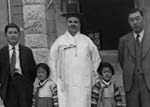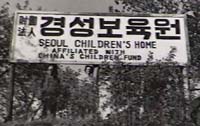Ironically, it was the ending of the war which put the children at risk of starvation again. Shortly after the Japanese surrendered in August 1945, the relief agencies pulled out of China one by one, thinking that their work was done. Mills soon learned that they were very low in cash, and the rice would be used up in a matter of weeks. So typical of the way he handled crisis, Mills asked the children to pray together. He then left for Canton.
Arriving on Sunday, he went to church. The speaker was Reverend Erwin Raetz of the Dutch Reformed Church of Grand Rapid, Michigan. After the service, Raetz asked Mills what had brought him to Canton. When Mills told him what he was doing in China, Raetz suggested Mills write to Dr. J. Calvitt Clarke, founder of China's Children Fund in Richmond, Virginia. As a contract chaplain of the American Advisory Committee, Mills was able to dispatch a letter to Clarke in unusual speed.
He then waited in Canton for the reply. Two weeks later, Mills received a cable from Clarke, agreeing to take in all 700 children. When Mills went back to the orphanages to share the good news with the children, one of the child said, "Pastor Mills, we prayed, didn't we?" Indeed, it was a direct answer from heaven!
"Taking in" meant that $2 per month per child would be sent from Richmond, Virginia to Canton, sufficient to purchase adequate supplies of rice for all the children under Mills' care. But the problem was that the rice had to be shipped by rail to Hunan province, then carried by coolies on a five and a half day journey over the mountains to the interior Kwong Tung area. Mills finally decided that the best way to ensure a reliable supply of rice for the children was to move all 700 of them to Canton.
Fortunately, through the personal introduction of the President of the Central Government, General Chiang Kai-Shek, Mills had become a good friend of the commander of the Southeast War Zone, General Cheung Fat-Foi. After learning about the need of the children, General Cheung took Mills to the other side of the Pearl River to see a confiscated Japanese school; with dining hall, kitchen, dormitories and playing field big enough to accommodate 700 children. Mills knew once again that was direct answer from heaven.
Mills then organized the children from the 5 orphanages to travel by foot for 2 days to the deep water town of Sam Fau. Again, with the help of General Cheung, the South China Steamship and Navigation Company provided two ships to take the children to Canton. Upon arrival, the boys were busy cleaning the facility; and the girls, making uniforms out of army surplus khaki fabric.
 After settling in,
Mills was concerned about the future of the children. He wanted to teach each one of them
a trade so that they could become independent and self-reliant. Therefore, with the help
of local craftsmen, he started a comprehensive technical training program in the
orphanage, covering a variety of areas including carpentry, plumbing, sheet metal,
masonry, farming, small engine repair, weaving, sewing and cooking. In addition, Mills
instituted morning devotions and evening prayer time in the orphanage, providing spiritual
feeding and guidance to the children as well.
After settling in,
Mills was concerned about the future of the children. He wanted to teach each one of them
a trade so that they could become independent and self-reliant. Therefore, with the help
of local craftsmen, he started a comprehensive technical training program in the
orphanage, covering a variety of areas including carpentry, plumbing, sheet metal,
masonry, farming, small engine repair, weaving, sewing and cooking. In addition, Mills
instituted morning devotions and evening prayer time in the orphanage, providing spiritual
feeding and guidance to the children as well. In 1946, Dr. Clarke came to China to see Mills' operation. Impressed with how Mills was able to turn orphan "outcasts" into productive members of the society, he asked Mills to join the China's Children Fund to become the organization's regional director of North China, Japan and Korea. Mills joined CCF in September 1947.

In January 1948, the Mills moved to Shanghai where the devastation from the Japanese invasion was the greatest. In a matter of months, Mills lined up 42 orphanages for CCF, assisting 5,113 children in Northern China. Simultaneously, he started the work in Korea and Japan.